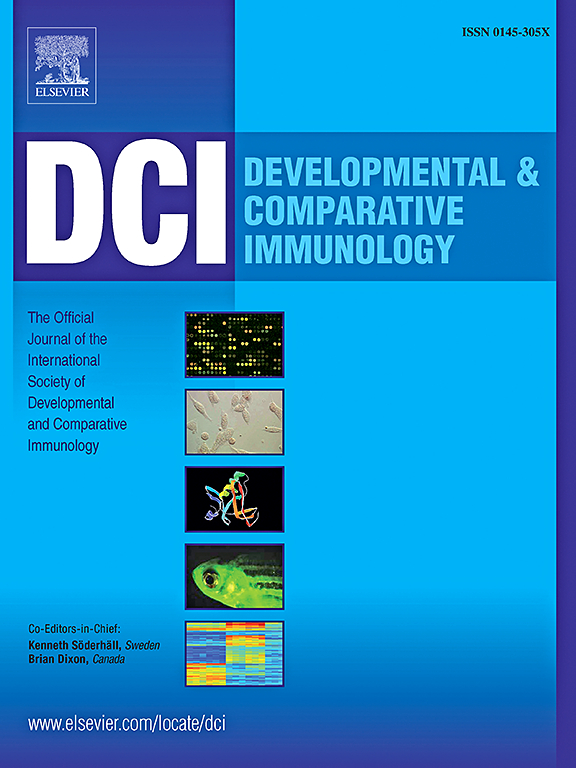鲶鱼免疫相关器官中嗜水气单胞菌毒性感染诱导的先天性免疫和适应性免疫基因表达谱。
IF 2.7
3区 农林科学
Q1 FISHERIES
引用次数: 0
摘要
嗜水气单胞菌(Aeromonas hydrophila)会导致淡水鱼发生运动性嗜水气单胞菌败血症(MAS)。近年来,毒性嗜水气单胞菌(vAh)引起的嗜水气单胞菌败血症在密西西比州和阿拉巴马州的商业鲶鱼养殖场造成了大规模损失。本研究旨在评估 vAh 菌株 ML09-119 感染期间鲶鱼免疫能力组织中的免疫基因表达。用 vAh 菌株 ML09-119 腹腔感染特定的无病原体鲶鱼幼苗,评估头部肾脏、脾脏和肝脏中 13 个免疫相关基因的相对表达。结果显示,感染后 2 小时(hpi),在鱼头肾脏、肝脏和脾脏中检测到了 vAh。感染后12小时检测到的vAh浓度最高,随后浓度下降,直至感染后5天(dpi)清除。基因表达分析显示,促炎细胞因子和先天性免疫反应(TLR 4 和 5)在感染后 24 小时内上调。脾脏和头部肾脏的适应性免疫相关基因分别在 7 dpi 和 14 dpi 出现上调。此外,免疫球蛋白 M 在头肾 14 dpi 和脾脏 21 dpi 出现显著上调。总之,vAh ML09-119 感染诱发了强烈的炎症反应,涉及多个先天免疫基因、促炎细胞因子和趋化因子。存活的鲶鱼能够清除感染并产生抗体和记忆细胞。评估 vAh 感染的免疫反应对于了解病原体的致病机制和开发 MAS 控制手段(包括疫苗开发和改进治疗方法)至关重要。本文章由计算机程序翻译,如有差异,请以英文原文为准。
Innate and adaptive immunity gene expression profiles induced by virulent Aeromonas hydrophila infection in the immune-related organs of channel catfish
Aeromonas hydrophila causes motile Aeromonas septicemia (MAS) in freshwater fish. In recent years, MAS outbreaks due to virulent Aeromonas hydrophila (vAh) have been responsible for large-scale losses within commercial catfish farms in Mississippi and Alabama. The aim of this study was to evaluate immune gene expression in catfish immune-competent tissues during infection with vAh strain ML09-119. Specific pathogen-free catfish fingerlings were intraperitoneally infected with vAh strain ML09-119, and relative expression of thirteen immune-related genes was evaluated from head kidney, spleen, and liver. Our results revealed that vAh was detected 2 h post-infection (hpi) in the head kidney, liver, and spleen. The highest concentration of vAh was detected at 12 hpi, from which point concentrations decreased until clearance at 5 days post-infection (dpi). Gene expression analysis revealed upregulation of pro-inflammatory cytokines and innate immune response (TLR 4 and 5) in the first 24 hpi. Adaptive immune-related genes were upregulated at 7 dpi in the spleen and 14 dpi in the head kidney. Furthermore, immunoglobulin M showed significant upregulation at 14 dpi in the head kidney and 21 dpi in the spleen. In summary, vAh ML09-119 infection induced a strong inflammatory response involving multiple innate immunity genes, proinflammatory cytokines, and chemokines. Surviving catfish were able to clear the infection and produce antibodies and memory cells. Assessment of the immunological response to vAh infection is critical for understanding the pathogen's mechanisms of pathogenesis and developing means for MAS control, including vaccine development and improved treatments.
求助全文
通过发布文献求助,成功后即可免费获取论文全文。
去求助
来源期刊
CiteScore
6.20
自引率
6.90%
发文量
206
审稿时长
49 days
期刊介绍:
Developmental and Comparative Immunology (DCI) is an international journal that publishes articles describing original research in all areas of immunology, including comparative aspects of immunity and the evolution and development of the immune system. Manuscripts describing studies of immune systems in both vertebrates and invertebrates are welcome. All levels of immunological investigations are appropriate: organismal, cellular, biochemical and molecular genetics, extending to such fields as aging of the immune system, interaction between the immune and neuroendocrine system and intestinal immunity.

 求助内容:
求助内容: 应助结果提醒方式:
应助结果提醒方式:


